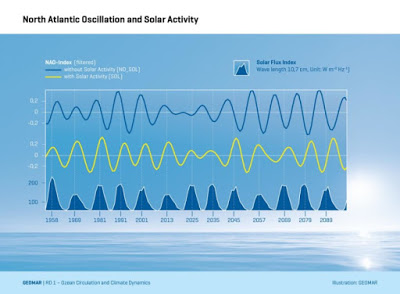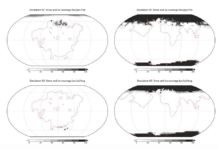
Are climate predictions over periods of several years reliable if weather forecast are still only possible for short periods of several days? Nevertheless there are options to predict the development of key parameters on such long time scales. A new study led by scientists at GEOMAR Helmholtz Centre for Ocean Research Kiel shows how the well-known 11-year cycle of solar activity affects the long-time development of dominant large-scale pressure systems in the Northern Hemisphere.
For their investigations the scientists used a coupled ocean-atmosphere model. In addition, this model includes an interactive chemistry module which can for instance cope with the effect of ultraviolet radiation (UV) in the upper atmosphere. This additional component seemed to be key to transmit the variations in the solar radiation which might have only a small direct impact on Earth’s surface, through a complex mechanism from the stratosphere (10-50 km altitude) to the lower atmosphere.
“We have carried out several experiments,” says Dr. Rémi Thiéblemont from GEOMAR, lead author of the study. “We conducted model experiments over a period of 145 years, with and without the influence of solar activity ,” Thiéblemont continued. The sun’s influence could clearly be identified in the so-called North Atlantic Oscillation, which is roughly speaking the pressure difference between the Azores high and the Iceland low. The ratio between these two pressure systems often determines the weather in Europe over longer time periods, such as whether the winter months turn warm and stormy or cold and snowy. The researchers found a time lag between variations in solar irradiance and atmospheric pressure patterns of about one to two years, which can be explained by an interaction between the atmosphere and the ocean. By comparing the two experiments with or without solar activity, they were able to prove for the first time that the sun irradiance serves as a phase-lock for the North Atlantic Oscillation. With this context, an increase of the predictability of the decadal NAO phase can be expected.
“The fact that the circulation in the upper atmosphere responds significantly to the solar fluctuations, is already known,” Prof. Dr. Katja Matthes, initiator and co-author of the study from GEOMAR explains. “On one hand we can demonstrate with this new study how the transmission of the signal to Earth’s surface and its interaction with the ocean works, and on the other hand we can show the importance of the chemical reactions for the coupling,” Prof. Matthes continued. So far, most global climate models have neither a sufficient resolution in the stratosphere nor interactive chemical components. “Although the solar effect on the North Atlantic Oscillation explains only a few percent of the total variance, the close relationship between solar activity and phase North Atlantic Oscillation is an important indicator to improve the predictability of climate variability,” Dr. Thiéblemont summarizes.
There is still a long way to go, for successful and reliable long-term forecasts up to a decade. Nevertheless, for successful predictions it is important to include solar fluctuations, Professor Matthes concludes.
Reference:
Rémi Thiéblemont, Katja Matthes, Nour-Eddine Omrani, Kunihiko Kodera, Felicitas Hansen. Solar forcing synchronizes decadal North Atlantic climate variability. Nature Communications, 2015; 6: 8268 DOI: 10.1038/ncomms9268
Note: The above post is reprinted from materials provided by Helmholtz Centre for Ocean Research Kiel (GEOMAR).










